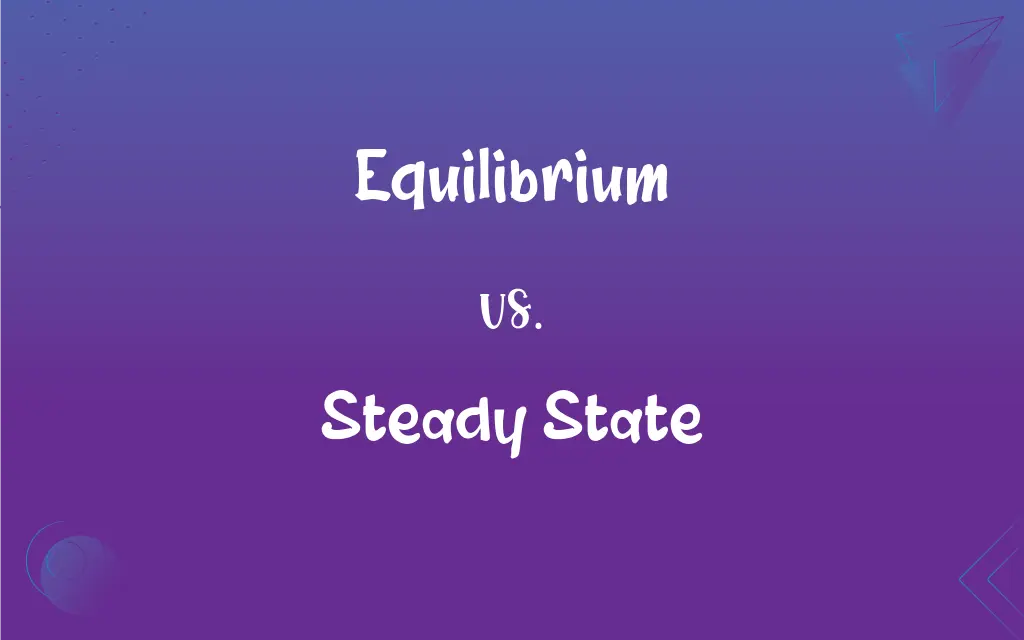Equilibrium vs. Steady State: What's the Difference?
Edited by Aimie Carlson || By Janet White || Published on September 10, 2024
Equilibrium is a state where opposing forces or influences are balanced, leading to no net change. Steady state is a condition where a system's variables remain constant over time despite ongoing processes.

Key Differences
Equilibrium refers to a balance among various components of a system, where dynamic processes occur but overall conditions remain static due to equal and opposite reactions. Steady state, in contrast, describes a situation where the input and output of a system are equal, maintaining constant system conditions over time. Both concepts imply stability, but they originate from different mechanisms and principles.
In thermodynamics, equilibrium is achieved when a system's properties, such as temperature and pressure, are uniform and do not change over time. This occurs when the rates of forward and reverse processes are equal. A steady state, however, does not necessarily imply thermodynamic balance but indicates that certain state variables are unchanging despite continuous energy and matter exchange. This distinction is crucial for understanding systems' behavior under various conditions.
Chemical equilibrium is a specific type of equilibrium where the concentrations of reactants and products remain constant because the forward and reverse reaction rates are equal. In contrast, a chemical system in a steady state maintains constant concentrations not because reactions stop, but because there is a continuous flow of reactants and products maintaining the concentration steady. This highlights the dynamic nature of steady states compared to the static nature of equilibrium conditions.
Biological systems often operate under steady state conditions rather than equilibrium. For example, cells maintain a steady state of ions across their membranes using energy to pump ions against their concentration gradients, a condition far from equilibrium but essential for life. This demonstrates how steady states can be maintained through constant energy input, differing from equilibrium, which requires no net energy flow once established.
Economically, an equilibrium market condition implies that supply equals demand, and there are no external forces prompting change. A steady state economy, however, suggests a condition where economic inputs and outputs are balanced in a way that can be maintained over the long term without depleting resources, even as individual transactions and dynamics continue. This illustrates the broader applicability and distinct implications of equilibrium and steady state concepts across disciplines.
ADVERTISEMENT
Comparison Chart
Definition
Balance among forces or reactions with no net change.
Constant system conditions over time despite ongoing processes.
Nature
Static, no net change in system variables.
Dynamic, continuous processes maintain constant variables.
Requirement
No external energy needed to maintain state.
Often requires continuous energy input.
Examples
Chemical equilibrium in reactions.
Constant temperature in a heated room.
Fields of Application
Physics, chemistry, economics.
Engineering, biology, environmental science.
ADVERTISEMENT
Equilibrium and Steady State Definitions
Equilibrium
In economics, the point where supply equals demand.
The market reaches equilibrium when the price of goods adjusts so that quantity demanded equals quantity supplied.
Steady State
In economics, a condition where the economy grows at the same rate as the population and technology, maintaining constant per capita income.
A steady state economy aims for sustainable growth without depleting natural resources.
Equilibrium
A state of balance where opposing forces cancel each other out.
A seesaw with equal weight on both sides is in equilibrium.
Steady State
A condition where a system's variables do not change over time despite ongoing processes.
A car engine reaches a steady state when it operates at a constant speed and temperature.
Equilibrium
In chemistry, a condition where reactant and product concentrations remain constant.
In a closed container, the water and vapor phase reach equilibrium at a specific temperature and pressure.
Steady State
In pharmacokinetics, the point at which the drug's intake and elimination rates are equal.
After multiple doses, the concentration of medication in the bloodstream reaches a steady state.
Equilibrium
A condition of emotional or mental balance and stability.
After a period of stress, meditation helped her find her emotional equilibrium.
Steady State
In electronics, the operational phase where a circuit's conditions remain constant over time.
The voltage across a resistor reaches a steady state soon after the circuit is powered on.
Equilibrium
In physics, a state where all forces acting on a body are balanced.
A book resting on a table is in mechanical equilibrium as the gravitational force is balanced by the table's support force.
Steady State
A constant condition in dynamic systems maintained by continuous inputs and outputs.
An ecosystem can be in a steady state when nutrient input and output are balanced.
Equilibrium
A condition in which all acting influences are canceled by others, resulting in a stable, balanced, or unchanging system.
Steady State
Characteristic of a steady state
Equilibrium
Mental or emotional balance.
FAQs
Is it possible for an ecosystem to be in equilibrium?
Ecosystems can reach a dynamic equilibrium where species populations remain stable, but they are more commonly in a steady state due to external influences.
What role does energy play in maintaining a steady state?
Energy input is often required to maintain a steady state, counterbalancing losses and driving continuous processes.
How does a steady state differ from equilibrium in a biological system?
A biological system in steady state maintains constant conditions through energy expenditure, unlike equilibrium, which requires no energy input.
How do feedback mechanisms relate to steady state and equilibrium?
Feedback mechanisms can help maintain a steady state by adjusting processes, while in equilibrium, they balance opposing forces or reactions.
Can an economy be both in equilibrium and a steady state?
An economy can be in equilibrium at a given moment, but a steady state refers to long-term sustainability, where economic activities don't deplete resources.
What indicates that a system has reached chemical equilibrium?
Constant concentrations of reactants and products without net change indicate chemical equilibrium.
How does a steady state economy address environmental concerns?
By balancing economic inputs and outputs, a steady state economy aims to reduce resource depletion and environmental degradation.
What is dynamic equilibrium?
Dynamic equilibrium occurs when continuous processes in a system counterbalance each other, maintaining a stable condition.
What defines equilibrium in a chemical reaction?
Equilibrium is reached when the rates of the forward and reverse reactions are equal, resulting in constant reactant and product concentrations.
How do engineers use the concept of steady state?
Engineers design systems, like reactors and engines, to operate under steady state for predictable and stable performance.
What distinguishes static from dynamic equilibrium?
Static equilibrium involves no movement, while dynamic equilibrium involves ongoing but balanced processes.
Can a physical object be in a steady state?
Yes, when conditions like temperature and pressure in an object remain constant over time despite heat exchange, it's in a steady state.
Why is steady state important in pharmacokinetics?
Achieving a steady state ensures that the drug's therapeutic effects are constant, optimizing treatment efficacy.
Can a system be in equilibrium if external forces are applied?
Yes, if the external forces are balanced by internal reactions, the system can still be in equilibrium.
What factors disrupt equilibrium in a chemical system?
Changes in temperature, pressure, or concentration can shift a chemical system out of equilibrium.
How does climate change impact steady states in nature?
Climate change can disrupt natural steady states, leading to biodiversity loss and ecosystem imbalance.
Can equilibrium occur in non-physical systems?
Yes, equilibrium can occur in non-physical systems, such as economic markets where demand equals supply.
How is steady state achieved in an electronic circuit?
When the current and voltage stabilize despite ongoing energy supply, an electronic circuit is in a steady state.
How do living organisms maintain steady states?
Through homeostasis, organisms maintain steady states by regulating internal conditions against external changes.
What challenges exist in maintaining a steady state economy?
Balancing economic growth with resource sustainability and addressing social inequalities are key challenges.
About Author
Written by
Janet WhiteJanet White has been an esteemed writer and blogger for Difference Wiki. Holding a Master's degree in Science and Medical Journalism from the prestigious Boston University, she has consistently demonstrated her expertise and passion for her field. When she's not immersed in her work, Janet relishes her time exercising, delving into a good book, and cherishing moments with friends and family.
Edited by
Aimie CarlsonAimie Carlson, holding a master's degree in English literature, is a fervent English language enthusiast. She lends her writing talents to Difference Wiki, a prominent website that specializes in comparisons, offering readers insightful analyses that both captivate and inform.






































































